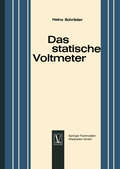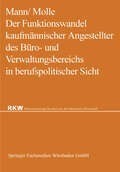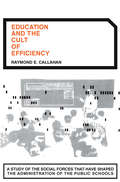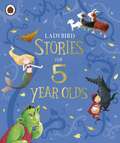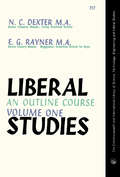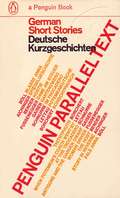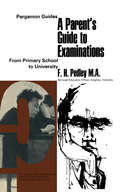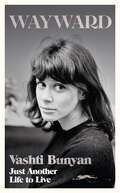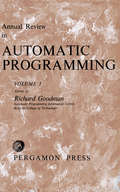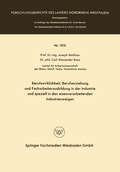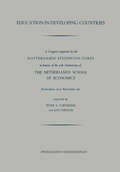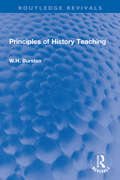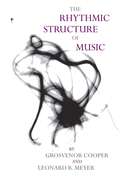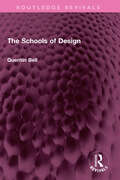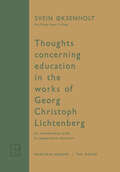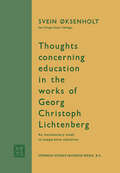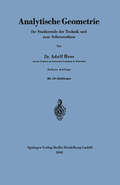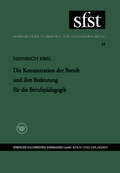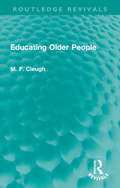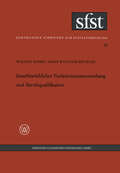- Table View
- List View
Das statische Voltmeter: Eine Darstellung seiner Bedeutung für den modernen Physikunterricht
by Heinz SchroderSeit einer Reihe von Jahren werden im Physikunterricht der Gymnasien Grund versuche zur Einführung in die wichtigsten Erkenntnisse der Atomphysik durch geführt. Diese erfreuliche Entwicklung wurde dadurch ermöglicht. daß die Lehrmittelindustrie geeignete Meßinstrumente zur Verfügung stellte. Heute besitzen viele Schulen einen sogenannten Meßverstärker. der es gestattet. loni 11 sationsströme in der Größenordnung von 10- A noch mühelos und sicher zu messen. Diese bewundernswerten Instrumente sind Meisterwerke der Elektronik und in ihrem Aufbau und ihrer Wirkungsweise den Benutzern, zumindest den Schülern, nicht ohne weiteres offenkundig. Diesem Sachverhalt entspricht der Preis, und es ist daher sicher nicht möglich und zu verantworten, daß eine Schule etwa mehrere Exemplare dieser Instrumente anschafft. um Schülerübungen zu veran stalten. Man müßte sich daher mit Demonstrationsversuchen begnügen. Im Rahmen der Reform des Oberstufenunterrichts anden Gymnasien ist es jedoch inzwischen eine vordringliche Aufgabe des Physikunterrichts geworden, die Schüler selbst an die wichtigsten Grundversuche der Oberstufenphysik heranzu fUhren. Dies erfordert ein Meßinstrument, das in seiner Leistungsfähigkeit dem Meßverstärker nicht wesentlich nachsteht und zu einem vertretbaren Preise be schafft werden kann; vor allem muß es in seiner Wirkungsweise leicht überschau bar und eine unmittelbare Anwendung der Grundgesetze der Elektrizitätslehre sein, ohne etwa bei seinem Gebrauch besondere Umsicht zu erfordern. Diese Bedingungen erfüllt in nahezu idealer Weise ein statisches Voltmeter (Elektro meter), das seit einigen Jahren als technisches Instrument im Handel ist.
Der Funktionswandel kaufmännischer Angestellter des Büro- und Verwaltungsbereichs in berufspolitischer Sicht (Rationalisierungs-Kuratorium der Deutschen Wirtschaft)
by Werner Mann Fritz MolleEducation and the Cult of Efficiency
by Raymond E. CallahanRaymond Callahan's lively study exposes the alarming lengths to which school administrators went, particularly in the period from 1910 to 1930, in sacrificing educational goals to the demands of business procedures. He suggests that even today the question still asked is: "How can we operate our schools?" Society has not yet learned to ask: "How can we provide an excellent education for our children?"
Education and the Cult of Efficiency: A Study Of The Social Forces That Have Shaped The Administration Of The Public Schools
by Raymond E. CallahanRaymond Callahan's lively study exposes the alarming lengths to which school administrators went, particularly in the period from 1910 to 1930, in sacrificing educational goals to the demands of business procedures. He suggests that even today the question still asked is: "How can we operate our schools?" Society has not yet learned to ask: "How can we provide an excellent education for our children?"
Education and the Cult of Efficiency: A Study Of The Social Forces That Have Shaped The Administration Of The Public Schools
by Raymond E. CallahanRaymond Callahan's lively study exposes the alarming lengths to which school administrators went, particularly in the period from 1910 to 1930, in sacrificing educational goals to the demands of business procedures. He suggests that even today the question still asked is: "How can we operate our schools?" Society has not yet learned to ask: "How can we provide an excellent education for our children?"
Education and the Cult of Efficiency
by Raymond E. CallahanRaymond Callahan's lively study exposes the alarming lengths to which school administrators went, particularly in the period from 1910 to 1930, in sacrificing educational goals to the demands of business procedures. He suggests that even today the question still asked is: "How can we operate our schools?" Society has not yet learned to ask: "How can we provide an excellent education for our children?"
Ladybird Stories for Five Year Olds
by LadybirdThis enchanting collection of six stories and fairy tales is perfect for sharing with your little one. Including classics such as 'Rapunzel', 'Jack and the Beanstalk' and 'The Little Mermaid', each tale is beautifully illustrated, making this an ideal gift. Includes: The Three Billy Goats GruffJack and the Beanstalk RapunzelThe Little MermaidAladdinLittle Red Riding Hood
Liberal Studies: An Outline Course
by N. C. Dexter E. G. RaynerLiberal Studies: An Outline Course, Volume 1 covers subjects that are less specific nature, but things that are interesting and important just the same. This book is composed of nine chapters, and begins with an important argument on why to maintain interests in liberal studies and related fields. Considerable chapters highlight the fundamental importance of some fields, including education, history, law, justice, patriotism, and nationalism. A chapter deals with the controversial issue of pacifism. The final chapters consider the issues and relevant questions concerning the relationship between scientific teachings and Christianity, including issues on creation, miracles, and purpose of life. These chapters also look into the concept of truth and the nature of reality. Each chapter contains discussion points and exercises. This book will prove useful to liberal science teachers and students, as well as the general public.
Parallel Text: Deutsche Kurzgeschichten
by Richard Newnham NoneMuch maligned in pre-war Germany, the short story enjoyed a creative rebirth in 1945. Initially imported by the Allies, the form also matched perfectly the prevailing mood of irony, objectivity and mistrust of the didactic. With the original German text running alongside English translations, this collection features stories from eight outstanding post-war authors including Heinrich Böll, Ilse Aichinger and Reinhard Lettau which students will find both educational and engrossing. Böll’s opening story 'Pale Anna' follows a soldier returning home, his situation comparable to that of the writer in the first months of peace: he knows no-one and has few words not linked to painful memories. This poignant narrative is followed by a variety of tales representing the diversity of the time and including satires, explorations of private obsessions and experiments in form and language.
A Parent's Guide to Examinations: From Primary School to University
by F. H. PedleyA Parent's Guide to Examinations: From Primary School to University provides an account of examinations in Wales and England from the primary school stage to the university. This book discusses the intense competition in universities that led to procedures being adopted for the administration of students.Organized into 12 chapters, this book begins with an overview of the examinations taken in the primary school in relation with selection for secondary schools. This text then describes the examinations themselves as well as some aspects of the system that has produced them. Other chapters consider the differences between the different types of schools, the organization of Local Education Authorities, and the administration of technical colleges and universities. This book discusses as well the courses for operatives, draftsmen, and technicians. The final chapter deals with grants for students at teacher training colleges.This book is a valuable resource for readers who are interested in the working of the system.
Wayward: Just Another Life to Live
by Vashti Bunyan'Magical and transporting . . . Wayward proves that Bunyan has lived the best possible life, on her own idiosyncratic terms'Maggie O'Farrell'A gorgeous account of outsiderness and survival: a map of how to live outside the boundaries and of striving for an authentic artistic life. A quietly defiant and moving work' Sinéad Gleeson'An epic in miniature . . . I loved - and lived - every sentence' Benjamin MyersIn 1968, Vashti Bunyan gave up everything and everybody she knew in London to take to the road with a horse, wagon, dog, guitar and her then partner. They made the long journey up to the Outer Hebrides in an odyssey of discovery and heartbreak, full of the joy of freedom and the trudge of everyday reality, sleeping in the woods, fighting freezing winters and homelessness. Along the way, Vashti wrote the songs that would lead to the recording of her 1970's album Just Another Diamond Day, the lilting lyrics and guitar conveying innocent wonder at the world around her, whilst disguising a deeper turmoil under the surface. From an unconventional childhood in post-war London, to a fledgling career in mid-sixties pop - recording a single written by Mick Jagger and Keith Richards - to the despair and failure to make any headway with her own songs, she rejected the music world altogether and left it all behind. After retreating to a musical wilderness for thirty years, the rediscovery of her recordings in 2000 brought Vashti a second chance to write, record and perform once more. One of the great hippie myths of the 1960s, Wayward, Just Another Life to Live, rewrites the narrative of a barefoot girl on the road to describe a life lived at full tilt from the first, revealing what it means to change course and her emotional struggle, learning to take back control of her own life.
Annual Review in Automatic Programming: International Tracts in Computer Science and Technology and Their Application
by Richard GoodmanAnnual Review in Automatic Programming focuses on the techniques of automatic programming used with digital computers. Topics covered range from the design of machine-independent programming languages to the use of recursive procedures in ALGOL 60. A multi-pass translation scheme for ALGOL 60 is described, along with some commercial source languages. The structure and use of the syntax-directed compiler is also considered.Comprised of 12 chapters, this volume begins with a discussion on the basic ideas involved in the description of a computing process as a program for a computer, expressed in a formal symbolic language such as ALGOL 60. The emphasis is on the information conveyed by the program constituents (semantics), rather than the particular form used (syntax). Subsequent chapters focus on generalized ALGOL; the design of machine-independent programming languages; JOVIAL, a programming language for real-time command systems; and a complete ALGOL translator, expressed in ALGOL itself. A detailed description of the compiler compiler is also presented, together with the Rapidwrite program. The final chapter is devoted to file processing in SEAL (Standard Electronic Accounting Language).This monograph will be of interest to computer programmers.
Berufswirklichkeit, Berufserziehung und Facharbeiterausbildung in der Industrie und speziell in den eisenverarbeitenden Industriezweigen (Forschungsberichte des Landes Nordrhein-Westfalen #1215)
by Joseph MathieuEducation in Developing Countries: Rotterdam, 18–20 November 1963
by Peter A. Cornelisse Jan VersluisPrinciples of History Teaching (Routledge Revivals)
by W.H. BurstonFirst published in 1963, Principles of History Teaching examines the nature of the teaching problem; historical events and the problem of teaching them; explanation in history and the arrangement of events for teaching; and problems of the syllabus. The book studies the relationship between practical problems of teaching history in school and theories about the nature of history as a subject.The reader will come to question that which before seemed obvious. This textbook on the theory of history teaching is for graduate students in training, for non-graduate teachers in training colleges who may like to study the problems they will face in greater detail, and for practising teachers to reconsider their outlook. They will all meet an adequate mental challenge.
Principles of History Teaching (Routledge Revivals)
by W.H. BurstonFirst published in 1963, Principles of History Teaching examines the nature of the teaching problem; historical events and the problem of teaching them; explanation in history and the arrangement of events for teaching; and problems of the syllabus. The book studies the relationship between practical problems of teaching history in school and theories about the nature of history as a subject.The reader will come to question that which before seemed obvious. This textbook on the theory of history teaching is for graduate students in training, for non-graduate teachers in training colleges who may like to study the problems they will face in greater detail, and for practising teachers to reconsider their outlook. They will all meet an adequate mental challenge.
The Rhythmic Structure of Music
by Grosvenor Cooper Leonard B. MeyerIn this influential book on the subject of rhythm, the authors develop a theoretical framework based essentially on a Gestalt approach, viewing rhythmic experience in terms of pattern perception or groupings. Musical examples of increasing complexity are used to provide training in the analysis, performance, and writing of rhythm, with exercises for the student's own work. "This is a path-breaking work, important alike to music students and teachers, but it will make profitable reading for performers, too."—New York Times Book Review "When at some future time theories of rhythm . . . are . . . as well understood, and as much discussed as theories of harmony and counterpoint . . . they will rest in no small measure on the foundations laid by Cooper and Meyer in this provocative dissertation on the rhythmic structure of music."—Notes ". . . . a significant, courageous and, on the whole, successful attempt to deal with a very controversial and neglected subject. Certainly no one who takes the time to read it will emerge from the experience unchanged or unmoved."—Journal of Music Theory The late GROSVENOR W. COOPER, author of Learning to Listen, was professor of music at the University of California at Santa Cruz.
The Schools of Design (Routledge Revivals)
by Quentin BellFirst published in 1963, The Schools of Design is a history of English Art Education. The story of the genesis of English art schools is one of the fierce conflicts in which private feuds mingle with questions of principle. It is a story of administrative chaos and open scandal in which some long-forgotten figures are involved; others – such as Haydon, Gladstone, Alfred Stevens, Dyce, Stafford Northcote, Etty and Henry Role – appear in a new role. In itself this forms an entertaining study full of incident and drama. Many of the problems that presented themselves in the 1840’s are still with us today and no one who is interested in the place of art in our society can afford to neglect the lessons of the Schools of Design. This book will be of interest to students of art and history.
The Schools of Design (Routledge Revivals)
by Quentin BellFirst published in 1963, The Schools of Design is a history of English Art Education. The story of the genesis of English art schools is one of the fierce conflicts in which private feuds mingle with questions of principle. It is a story of administrative chaos and open scandal in which some long-forgotten figures are involved; others – such as Haydon, Gladstone, Alfred Stevens, Dyce, Stafford Northcote, Etty and Henry Role – appear in a new role. In itself this forms an entertaining study full of incident and drama. Many of the problems that presented themselves in the 1840’s are still with us today and no one who is interested in the place of art in our society can afford to neglect the lessons of the Schools of Design. This book will be of interest to students of art and history.
Thoughts Concerning Education in the Works of Georg Christoph Lichtenberg: An Introductory Study in Comparative Education
by Svein OksenholtThis is an investigation of the thoughts concerning education in the writings of one of the most original educators of the eighteenth century. Unappreciated and largely overlooked - as was Schopenhauer - by the contemporary educators, Lichtenberg nevertheless presented his generation, and generations to come, with some of the most useful (a great life aim of Horace Mann!) suggestions pertaining to education that may possibly be found anywhere in the annals of classical edu cation. Beginning with a biographical sketch of Lichtenberg, it presents an analysis of his philosophy of education, discusses Lichtenberg's thoughts on pedagogy and curriculum, analyzes his conception of morals and religion to the extent that these ideas are specifically related to education, examines his notions of educational psychology, determines Lichtenberg's views on British education in the eighteenth century, compares some of Lichtenberg's educational ideas in the works of contemporary thinkers and educators, notably Schopenhauer, James and Dewey. A concomitant aspect of this book is a portrayal of Lichtenberg as found in his works, viz., as a student, professor, philosopher, educator, moralist, psychologist, comparative educationist, as a searcher for absolute educational truth - attainable only in a world to come. SVEIN 0KSENHOLT, PH. D.
Thoughts Concerning Education in the Works of Georg Christoph Lichtenberg: An Introductory Study in Comparative Education
by Svein ØksenholtThis is an investigation of the thoughts concerning education in the writings of one of the most original educators of the eighteenth century. Unappreciated and largely overlooked - as was Schopenhauer - by the contemporary educators, Lichtenberg nevertheless presented his generation, and generations to come, with some of the most useful (a great life aim of Horace Mann!) suggestions pertaining to education that may possibly be found anywhere in the annals of classical edu cation. Beginning with a biographical sketch of Lichtenberg, it presents an analysis of his philosophy of education, discusses Lichtenberg's thoughts on pedagogy and curriculum, analyzes his conception of morals and religion to the extent that these ideas are specifically related to education, examines his notions of educational psychology, determines Lichtenberg's views on British education in the eighteenth century, compares some of Lichtenberg'S educational ideas in the works of contemporary thinkers and educators, notably Schopenhauer, J ames and Dewey. A concomitant aspect of this book is a portrayal of Lichtenberg as found in his works, viz., as a student, professor, philosopher, educator, moralist, psychologist, comparative educationist, as a searcher for absolute educational truth - attainable only in a world to come. San Diego State College SVEIN 0KSENHOLT, PH. D.
Die Konzentration der Berufe und ihre Bedeutung für die Berufspädagogik (Dortmunder Schriften zur Sozialforschung #22)
by Heinrich EbelErster Anlaß und Ausgangspunkt der vorliegenden Arbeit war eine sozial wissenschaftliche Untersuchung unter dem Arbeitstitel "Betrieblicher Status und Lebensbereich", die von der Sozialforschungsstelle an der Universität Münster, Sitz Dortmund, in den Jahren 1957 bis 1959 unter der Leitung von Professor Dr. Linde durchgeführt wurde. Bei dieser Untersuchung und Auswertung fiel mir die Bearbeitung des Materials und die Abfassung eines Teilforschungsberichtes unter dem Thema "Die industrielle Arbeitswelt als Berufswirklichkeit" zu. Dabei wurde mir klar, daß bestimmte Feststellungen der Untersuchung von weittragender berufspädagogischer Bedeutung sein könnten. Ich bin dieser Frage nachgegangen und lege das Ergebnis meiner Arbeit hiermit vor. Mein Dank gilt in besonderem Maße Herrn Professor Dr. Helmut Schelsky, der die Arbeit betreute und Herrn Professor Dr. Hans Linde, der als Abteilungsleiter der Sozialforschungsstelle mir dazu Material, Möglich keit und Anregung bot. Mein Dank gilt weiterhin meinen Kollegen von der Sozialforschungsstelle, die die im Rahmen dieser Arbeit anfallenden Probleme mit mir diskutierten, und nicht zuletzt all jenen Arbeitern, Angestellten und Unternehmern, die sich in unseren Befragungen bereitwillig und offen zu intensiven Gesprächen zur Verfügung gestellt haben. Die Arbeit ist meiner Mutter gewidmet. INHALTSVERZEICHNIS EINLEITUNG 9 1. KAPITEL Kenntnisse der Berufswelt und Möglichkeiten der Berufswahl bei Jugendlichen. . . . . . . . . . . . . . . . . . . . . . . . . . . . . . . . . . 11 . . . . . . . . . . . . . . 1. Berufskenntnisse als distanzierte Kindheitserfahrungen ......... 11 H. Die Institutionalisierung des Berufswechsels. . . .. .. . . .. .. ... . .. . . 14 2. KAPITEL Die Berufswahl als Entscheidung für Berufe der entwickelten industriellen Gesellschaft ........................................ 17 1. Berufswünsche von Jugendlichen und Industriebeschäftigten in einer kleineren Gemeinde ......................................... 17 H. Berufswahl und Berufswünsche der Schulentlaßlinge der Bund- republik in den letzten Jahren .. . . . . . . . . . . . . . . . . . . . . . . 19 . . . . . . . .
Educating Older People (Routledge Revivals Ser.)
by M. F. CleughOriginally published in 1962, the purpose of this book was to examine the working of the educative process when it is concerned with older people; not with children, prisoners, willing or unwilling, of a system of basic education, but voluntary contractors; not green, pliable saplings, but sturdy and sometimes unbending timber – in short, adults with an outlook on life already formed, often with family responsibilities, and with a store of past experience, special interests, training, or expertise. The teaching of older people does not consist merely of the adaptation of the methods applicable to school or college to the intellectual level of those to whom time and opportunity may have given an already broad understanding, theoretical or empirical, of a variety of subjects. The teaching of adults must take full account of method, but whatever the context, is also much concerned with the interrelations between individuals in groups, and with changes in the individuals themselves. For the adult, in the main, the purpose of education is improvement; this may imply a feeling of dissatisfaction with standards already achieved or a strong determination to reach new educational goals for specific reasons connected with status or advancement. These factors often bring with them into the setting of the adult class anxieties, tensions, feelings of inadequacy, or burdens of responsibility that overshadow the learning process because of the importance of the outcome. Habits and attitudes may already have been formed that stand in the way of assimilating new patterns and techniques of learning. This book is concerned with the social and psychological factors of which account must be taken in approaching the teaching of adults. It considers methods of teaching and of learning, and proceeds to inquire into the deeper attitudinal influences at work, both in the teacher and in the student. Throughout the book theory is illustrated by the liberal use of examples.
